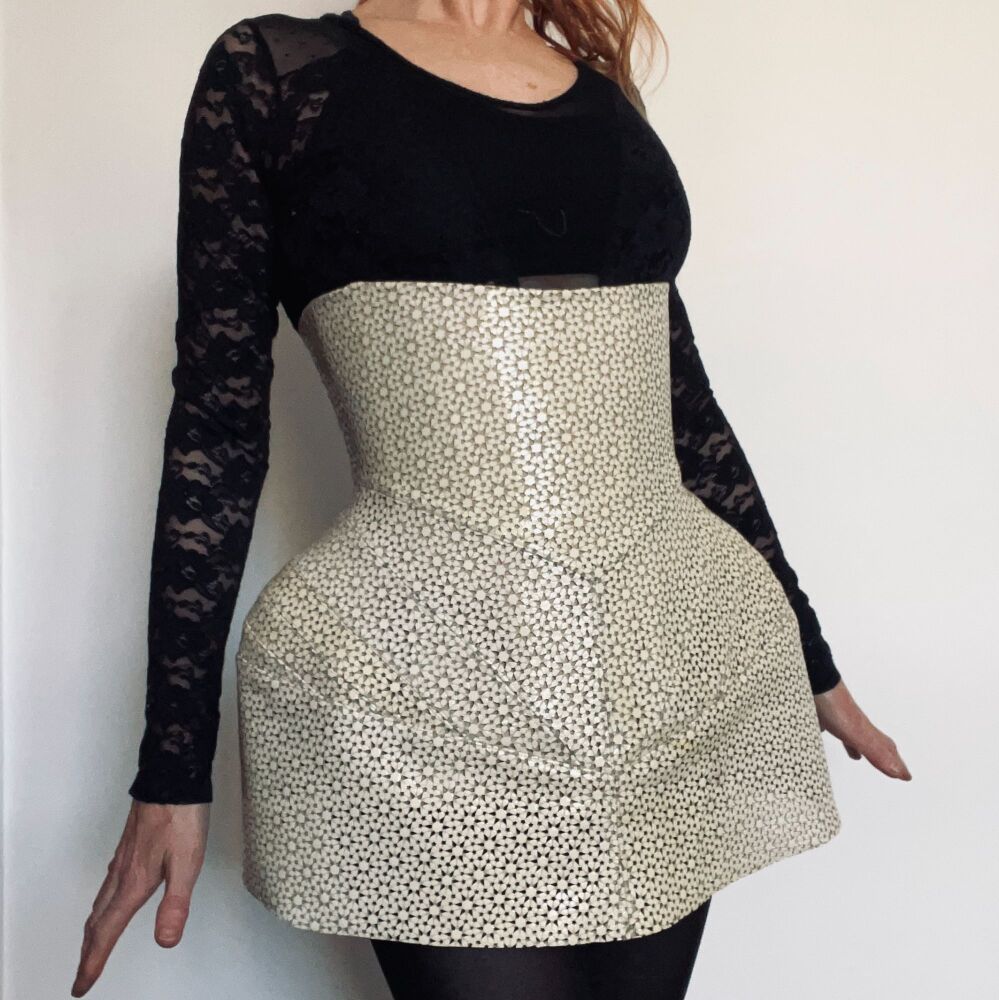Latest design progress - the mini crini
Posted on

Every design needs an example for marketing photos, and I use this opportunity to fine tune the seams as I move towards my final pattern. The initial draping work is achieved with calico fabric which is always going to present differently than using coutil (non-stretch corsetry fabric) so I need to test the pattern in coutil; the recommended fabric (mock up coutil will often be incorporated into the final garment as the inner strength layer or even as the outer if making a single layer and it hasn’t become damaged or warped in the process).
At this stage it is good practise to start the instructions – I note down every step being carried out including all the fine details such as the best way to press the seam allowances.
If the initial toile showed some oddities in terms of fabric wrinkling, I may also slightly adjust the fabric grainline on one side so I can compare the two sides and use the better angle. I’ve learned it’s best not to get too pernickety about this though as you can fall down a rabbit hole appearing weeks later with maybe only a slight improvement; there are so many panel combinations and tests on angles you can do that it can become very confusing.
It is important to always take notes and mark up versions on the test patterns. I have a system in my CAD pattern of copying the whole pattern over (left to right) with each amendment / date – the working CAD drawing can end up quite large with all my changes over time.
Once the corset was made up in coutil to my size, I boned it minimally and tried it for size and comfort. I’m lucky in that I am a standard size so I can try the ‘out of the box’ size without any need for adjustment. A lot of corset makers prefer a highly boned corset, but I prefer to bone as minimally as possible and let the fabric do the work. The rule of thumb is a bone every 2’’ of waist but for initial testing I may only bone every 4’’ – this is worst case scenario and will show me what extra boning is required.
At this stage I found that the bottom panel needed to be pulled higher and tighter towards the centre front to stop it splaying outwards; it helped with the rounded hip shaping that I was trying to achieve. This was the only change I needed to make to the pattern.
I finished the inner coutil layer by sewing in the extra boning channels I thought necessary and pressed under the top and bottom hems. Structural corsets like this where you are not using the body itself to fill out the hips benefit from the strongest, most sturdy of fabrics as the outer layer, and leather is perfect. When using leather as the outer layer I don’t roll-pin; leather has a slight stretch and if I make it to the same size as the coutil inner layer it will mould nicely (snap to size) when on the body. Here is the just the leather layer– you can see even without the coutil that it is holding its shape nicely;

I faced the leather to the coutil inner layer and pad-stitched it in place ensuring the seams were lined up. The seams can often mismatch by a mm or 2 but as the vertical stretch is important I stitched the seams where they fell on the coutil rather than the seams to prevent ‘bagging’. Once I was happy with how the two layers were faced, I sewed the centre back boning channels through both the leather and coutil, inserted the bones and eyelets, and secured the top line by sewing the leather in place by folding the leather over the coutil and securing it on the wrong side.
I hand stitched the leather outer to the coutil at the bottom most horizontal seam to give it some vertical tension and to keep the two layers from shifting.
I had sewn together only part of the hip panels in 3mm thick felt to give it the structural support it required over the hip but found it dropped a bit at the side back, so one more felt panel was added and voila; a fully rounded supported hip that I had intended.
My CAD base pattern and corset prototype is now complete - now for the final part; grading this complex pattern into different sizes and testing, plus finalising the instructions which may need diagrams to be drawn to illustrate the process.
Add a comment: